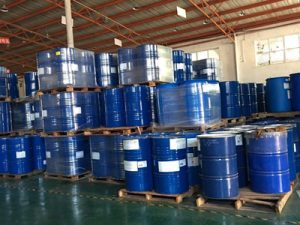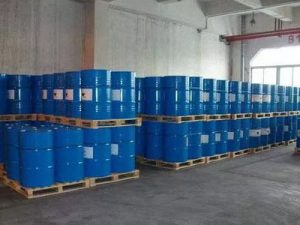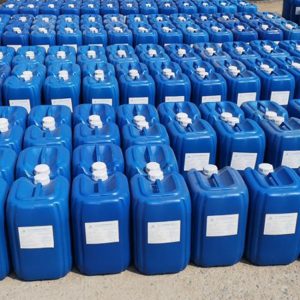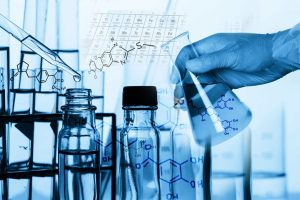Difference between water-based inorganic zinc-rich and epoxy zinc-rich
Waterborne inorganic zinc-rich paint is a high modulus silicate as a binder, with ultrafine high activity zinc powder as the main rust pigment two-component room temperature curing waterborne coatings Waterborne inorganic zinc-rich coatings and its main pigment is zinc powder, in order to ensure that the zinc powder in zinc-rich primer can be tightly bonded to the grass-roots steel to play a role in electrical conductivity and sacrifice of the anode, the inter-zinc-rich primer for different types of zinc powder content to do the provisions of inorganic zinc-rich primer, zinc powder should not be less than 74% of the total mass of the dry film. Inorganic zinc-rich primer, the total mass of zinc powder in the dry film should be not less than 74%, the fineness of the zinc powder selection, should be greater than 325 mesh, 500 mesh is better. In addition, in the coating, add appropriate amount of zinc powder other than pigments, such as silica or iron phosphate powder, so that it is well dispersed in the inorganic zinc-rich coatings, can make the coating cracking tendency is greatly reduced.

Comparison of water-based inorganic zinc-rich and epoxy zinc-rich coatings
1 Performance comparison
1.1 Properties
Water-based inorganic zinc-rich coatings to silicate as a film-forming reactants and zinc reaction to generate zinc silicate mesh structure, so it can be called inorganic zinc silicate coatings, is a green environmentally friendly coatings.
Epoxy zinc-rich coatings are organic coatings with epoxy resin as the film-forming material and organic solvent as the diluent.
1.2 Adhesion
Water-based inorganic zinc-rich coatings due to the reaction of silicate and zinc powder at the same time also react with the steel to form zinc iron silicate complex, thus forming a strong chemical bond on the surface of the steel, which can resist the erosion of water, seawater, organics, chlorides and so on.
Epoxy zinc-rich paint adhesion by the resin on the steel surface of the bond, is a physical adsorption, the initial adhesion is better, but the weathering of organics is poor, in harsh environments are more susceptible to aging, so that the adhesion is slowly reduced.
1.3 Corrosion resistance
Zinc-rich paint anti-corrosion mechanism is through the zinc and steel substrate surface direct contact, when the corrosion medium penetrates into the paint film and steel interface will form a primary battery composed of zinc – iron and steel, due to the electrochemical activity of zinc (the standard electrode potential of -0.763 V) more active than iron (-0.449 V), zinc for the anode and sacrificed to the loss of electrons, iron for the cathode to get the electrons and get protection, that is, the so-called zinc plays a Cathodic protection.

In addition to the sacrifice of zinc formation Zn 2 + and air moisture and carbon dioxide reaction to generate alkaline zinc carbonate [3Zn (OH) 2 – 3ZnCO 3] and other products, these insoluble in water, non-conductive corrosion products filled in the paint film void, such as a point of the zinc powder has been consumed (or there is a leakage point or defects) then the corrosion products will be deposited on the substrate in this case the formation of a dense membrane, blocking The result of these reactions is the so-called zinc-rich paint with self-repairing properties.
Whether water-based inorganic zinc-rich paint or epoxy zinc-rich paint, have cathodic protection and self-repair performance.
But water-based inorganic zinc-rich coatings due to silicate reaction with zinc powder at the same time also react with the substrate metal iron reaction to form a strong chemical bond, and epoxy zinc-rich coatings for physical adsorption only, and organic conductive properties of the poorer, to obtain the same cathodic protection effect, epoxy zinc-rich coatings in the zinc content of the dry film should be higher. For example, the U.S. Steel Structure Painting Association SSPC a model of zinc-rich paint on the zinc powder content of the regulations, in order that the paint can conduct electricity and cathodic protection, the minimum content of zinc in the dry film of this type of paint: inorganic zinc-rich 74%, epoxy zinc-rich is 77%. In addition, there are experiments to prove that inorganic zinc-rich and epoxy zinc-rich primer by adding iron phosphate powder Fe 2 P to replace part of the zinc powder, the cathodic protection time for inorganic zinc-rich paint, even if the Fe 2 P content of 24% and does not contain Fe 2 P is basically the same, but for epoxy zinc-rich coatings, even if the zinc content of up to 97%, its corrosion resistance is still far less than the inorganic zinc-rich coatings, but a small amount of Fe 2 P, the cathodic protection effect will be rapidly. A small amount of Fe 2 P, its cathodic protection will quickly disappear.
Therefore, the corrosion resistance of inorganic zinc-rich coatings is far better than epoxy zinc-rich coatings. According to the National Aeronautics and Space Administration (NASA) report (Table 1), among the various types of zinc-rich coatings, the best corrosion resistance is the waterborne inorganic zinc-rich coatings, which have a service life of at least 25 years under marine atmospheric conditions.

Type of Coating
Epoxy zinc-rich coatings
Solvent-based inorganic zinc-rich coatings
Waterborne inorganic zinc-rich coatings
Service life (years)
3~5
12~15
25
1.4 Heat resistance
All kinds of components in the project after painting primer, the next step in the assembly of cutting and welding is the main processing operations, so the primer can be cut and weldability, that is, its heat-resistant performance is very important, that is, in the operation of the paint film should be a small area of the burn area, the general spread should be within 10-25 mm, water-based inorganic zinc-rich coatings in the formation of hardened film in order to poly-siloxane (Si – O) combination, this Si – O bonding energy of 445.2 kJ/mol, than the formation of organic polymers C – C bonding. – Si) combination, this Si – O bonding energy of 445.2 kJ/mol, than the formation of organic polymer C – C bonding energy (346.9 kJ/mol) is much larger, and thus the inorganic zinc-rich coatings than the epoxy zinc-rich coatings have a stronger heat-resistant, long-term resistance to 400 ℃, instantaneous 800 ℃. 400 ℃, instantaneous 800 ℃. Obviously in the welding and cutting and other thermal processing burn area of the former than the latter to be smaller.
1.5 Conductivity
Generally can be used to prevent and eliminate static electricity conductive coating resistivity of 10 6-10 8 Ω – cm. When water-based inorganic zinc-rich paint dry film zinc content ≥ 74%, its resistivity is generally 10 3-10 8 Ω – cm (in line with the Ministry of Petroleum anti-static standards), much lower than the general conductive coatings, that is, water-based inorganic zinc-rich coatings to eliminate static electricity is much better than the general conductive coating performance. According to reports, in various types of large crude oil storage tanks, solvent storage tanks and fuel oil storage tanks using inorganic zinc-rich coatings coating success has been a lot of examples.
Because of the poor electrical conductivity of organic materials, epoxy zinc-rich conductivity is not as good as water-based inorganic zinc-rich coatings.

Types of coatings
General Conductive Coatings
Epoxy zinc-rich coatings
Water-based inorganic zinc-rich coatings
Resistivity (Ω.cm)
1000000-100000000
>10000000
<100000
1.6 Organic solvent resistance
This is an outstanding performance of water-based inorganic zinc-rich coatings, almost insoluble in all hydrocarbon solvents (including crude oil, fuel oil, gasoline, toluene, xylene and other aliphatic and aromatic hydrocarbon petroleum products). It is highly resistant to many strong solvents such as ethers, ketones and chlorinated hydrocarbons.
Epoxy zinc-rich coatings, because of the epoxy resin as a binder, is organic, obviously the resistance to crude oil, etc. is far less than water-based inorganic zinc-rich coatings.
1.7 Environmental safety
Water-based inorganic zinc-rich coatings use water as the diluent, with zero VOC emission, no flash point, non-flammable, non-explosive, odorless, non-toxic and non-polluting. It not only protects the health of workers and the comfort of the environment, but also does not need to take any fire prevention measures, greatly simplifies the construction conditions, saves money and improves efficiency and safety.
Epoxy zinc-rich coatings, not only the epoxy resin itself is organic, and organic solvents, such as benzene, xylene, etc., as a diluent, it is clear that its environmental protection and safety can not be compared with the water-based inorganic zinc-rich coatings.
1.8 Supporting performance
Generally speaking, epoxy zinc-rich coatings are easier to match with various types of paint, water-based inorganic zinc-rich coatings in addition to oil-based paint and alkyd paint can not be matched, can be used with the epoxy, acrylic, polyurethane, vinyl paint matching, such as epoxy transition layer paint can be coated with more paint matching, and the effect is better!
Although generally speaking, the matching performance of water-based inorganic zinc-rich primer is not as good as epoxy zinc-rich primer, but at present there are still many varieties of topcoats that can be matched to fully meet the needs of anticorrosive engineering.
1.9 Construction performance
(1) Substrate surface treatment
Water-based inorganic zinc-rich paint in the film-forming process and the formation of chemical bonds on the surface of steel, so the surface of the substrate treatment requirements are stringent, must reach Sa 2.5 level, and make the surface have a certain degree of roughness, increase the surface area, to ensure that the zinc powder can be in close contact with the steel.
Epoxy zinc-rich coatings adhesion is mainly contributed by the physical adsorption of organic resins on the substrate, so the degree of surface treatment of the substrate can be correspondingly reduced to Sa 2.0 level, but the actual construction is also required to reach Sa 2.5 level. It is worth pointing out that in the field of heavy corrosion, Sa 2.5 level is commonly used level, the current sand blasting (shot blasting) technology can be achieved.
(2) Construction environment
Water-based inorganic zinc-rich coatings use water as the diluent, and only through the evaporation of water can the wet film form a dense mesh structure of zinc silicate paint film, so this type of paint is more sensitive to the construction environment, such as temperature, humidity, wind and so on, compared with epoxy zinc-rich coatings due to the use of organic solvents as a diluent, less subject to the influence of the environment.
It is worth mentioning that WSP water-based inorganic zinc-rich coatings can meet the construction requirements under different environmental conditions. In addition, for the automatic painting line operation, because of the basic closed type, greatly reducing the influence of the external climate environment, water-based inorganic zinc-rich coatings are very favorable to the construction.
2 Conclusion
(1) water-based inorganic zinc-rich coatings because of its silicate binder reacts with zinc powder at the same time also reacts with the substrate steel, the Department of chemical bonding combined with its corrosion resistance, as a heavy-duty anticorrosive coatings service life, greatly superior to the epoxy zinc-rich coatings.
(2) water-based inorganic zinc coating film of heat resistance, organic solvent resistance, electrical conductivity are better than epoxy zinc coating film, and therefore more suitable for all types of oil storage tanks as internal anti-corrosion coatings.
(3) Obviously, water-based inorganic zinc-rich coatings are much better than epoxy zinc-rich coating environmental safety performance.
(4) Although water-based inorganic zinc-rich coatings are more sensitive to the construction environment conditions, water-based inorganic zinc-rich coatings have been greatly improved in this regard, and can be adapted to the needs of different construction environments.
(5) As environmental protection has become more and more concerned by the world, countries to save energy and control VOC emissions, the formulation of increasingly stringent regulations, people’s awareness of environmental protection is also growing, try to use high quality and environmentally friendly products has become a consensus, water-based inorganic zinc-rich coatings instead of epoxy zinc-rich coatings has become a trend.

